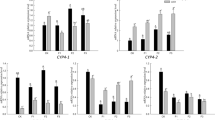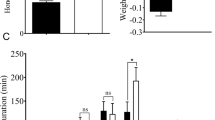Abstract
The western flower thrips, Frankliniella occidentalis (Pergande) is an economically important invasive pest. It shows different preferences for various vegetables. This study investigated the responses of detoxification enzyme and gene expression in F. occidentalis when thrips were transferred from kidney bean pods to new hosts kidney bean plant and broad bean plant. Variations in the activities and gene expressions of carboxylesterase (CarE), glutathione S-transferase (GSTs) and cytochrome P450 monooxygenases (P450) in F. occidentalis in F1, F2 and F3 generations were determined on new hosts. The results showed that activities and gene expression of detoxification enzymes were significantly influenced by the host, stage and generation, and there were significant interactions in most situations between the two factors and among three factors. After transferring to kidney bean plant, the activities of the detoxification enzymes exhibited a similar pattern of variation, with maximal levels observed in the F1 generation. By the F3 generation, activities of CarE and GSTs in 2nd instar larvae remained higher than the control group. When F. occidentalis were transferred to broad bean plant, the activities of CarE and P450 in 2nd instar larvae and adults also rose. The expressions of CL4503.Contig2 in F. occidentalis significantly decreased after transfer to kidney bean plants, while it was significantly up-regulated after thrips were transferred to broad bean plant. However, the expressions of CL992.contig14, CL1914.Contig2 and Unigene18748 in three generations significantly decreased. The results indicated that F. occidentalis was able to rapidly respond by altering the activities of its detoxification enzymes and related genes expressions, thereby gradually adapting to different hosts in each successive generation.



Similar content being viewed by others
References
Baumgartner FA, Motti CA, de Nys R et al (2009) Feeding preferences and host associations of specialist marine herbivores align with quantitative variation in seaweed secondary metabolites. Mar Ecol Prog 396:1–12
Bradford MM (1976) A rapid and sensitive method for the quantitation of microgram quantities of protein utilizing the principle of protein-dye binding. Anal Biochem 72(1–2):248–254
Calla B, Noble K, Johnson RM et al (2017) Cytochrome P450 diversification and hostplant utilization patterns in specialist and generalist moths: Birth, death and adaptation. Mol Ecol 26(21):6021–6035
Castañeda LE, Figueroa CC, Fuentes-Contreras E et al (2009) Energetic costs of detoxification systems in herbivores feeding on chemically defended host plants: a correlational study in the grain aphid Sitobion Avenae. J Exp Biol 212(8):1185–1190
Celorio-Mancera MDLP, Heckel DG, Vogel H (2012) Transcriptional analysis of physiological pathways in a generalist herbivore: responses to different host plants and plant structures by the cotton bollworm Helicoverpa Armigera. Entomol Exp Appl 144(1):123–133
Chen RF (2011) Studies on Host-adaptation of Frankliniella occidentalis. Fujian Agriculture and Forestry University Press, Fuzhou (in China)
Chen J, Li C, Yang Z (2015) Identification and expression of two novel cytochrome P450 genes, CYP6CV1 and CYP9A38, in Cnaphalocrocis medinalis (Lepidoptera: Pyralidae). J Insect Sci 15(1):50–50
Crava CM, Brutting C, Baldwin IT (2016) Transcriptome profiling reveals differential gene expression of detoxification enzymes in a hemimetabolous tobacco pest after feeding on jasmonate-silenced Nicotiana attenuata plants. BMC Genomics 17(1):1005
Cronin JT, Abrahamson WG, Craig TP (2010) Temporal variation in herbivore host-plant preference and performance: constraints on host-plant adaptation. Oikos 93(2):312–320
Dermauw W, Pym A, Bass C et al (2018) Does host plant adaptation lead to pesticide resistance in generalist herbivores ? Curr Opin Insect Sci 26:25–33
Dixon DP, Skipsey M, Edwards R (2010) Roles for glutathione transferases in plant secondary metabolism. Phytochemistry 71(4):338–350
Dong HG, Xie ZJ, Du YZ et al (2015) Cloning and mRNA expression analysis of cDNA fragments of cytochrome P450 genes in Frankliniella occidentalis. J Environ Entomol 37(6):1188–1194
Donkor D, Mirzahosseini Z, Bede J et al (2019) Detoxification of host plant phenolic aglycones by the spruce budworm. PLoS ONE 14(5):e0208288
Escobar-Bravo R, Nederpel C, Naranjo S et al (2019) Ultraviolet radiation modulates both constitutive and inducible plant defenses against thrips but is dose and plant genotype dependent. J Pest Sci 94(1):69–81
Hasheminia SM, Sendi JJ, Jahromi KT et al (2013) Effect of milk thistle, Silybium marianum, extract on toxicity, development, nutrition, and enzyme activities of the small white butterfly Pieris Rapae. J Insect Sci 13(1):146
He Z, Guo JF, Reitz SR et al (2020) A global invasion by the thrip, Frankliniella occidentalis: Current virus vector status and its management. Insect Sci 27(4):626–645
Jin M, Liao C, Fu X et al (2019) Adaptive regulation of detoxification enzymes in Helicoverpa armigera to different host plants. Insect Mol Biol 28(5):628–636
Kalske A, Leimu R, Scheepens JF et al (2016) Spatiotemporal variation in local adaptation of a specialist insect herbivore to its long-lived host plant. Evol 70(9):2110–2122
Karuppaiah V, Srivastava C, Subramanian S (2016) Effect of host plants on insecticide susceptibility and detoxification enzymes activity in Spodoptera litura Fabricius (Noctuidae: Lepidoptera). Proc Natl Acad Sci, India, Sect B 86(3):715–721
Kirsch R, Vogel H, Muck A et al (2011) Host plant shifts affect a major defense enzyme in Chrysomela lapponica. Proc Natl Acad Sci 108(12):4897–4901
Krempl C, Heidel-Fischer HM, Jimenez-Aleman GH et al (2016) Gossypol toxicity and detoxification in Helicoverpa armigera and Heliothis virescens. Insect Biochem Mol Biol 78:69–77
Kumrungsee N, Pluempanupat W, Koul O et al (2014) Toxicity of essential oil compounds against diamondback moth, Plutella xylostella, and their impact on detoxification enzyme activities. J Pest Sci 87(4):721–729
Li JZ, Zhi JR, Gai HT (2011) Effects of host plants and temperature on Frankliniella occidentalis growth and development. Chin J Ecol 30(3):558–563
Li L, Yuan Y, Wu L et al (2018) Effects of host plants on the feeding behavior and detoxification enzyme activities in Hyphantria cunea (Lepidoptera: Arctiidae) larvae. Acta Entomol Sin 61(2):232–239
Liu B, Coy M, Wang JJ et al (2015) The effect of host plant species on the detoxifying enzymes of the Asian citrus psyllid, Diaphorina citri (Hemiptera: Liviidae). Fla Entomol 98(3):997–999
Liu Y, Qi M, Dietrich CH et al (2019) Comparative sialotranscriptome analysis of the rare Chinese cicada Subpsaltria yangi, with identification of candidate genes related to host-plant adaptation. Int J Biol Macromol 130:323–332
Liu L, Zhi JR, Yue WB et al (2020) The response of P450 genes in Frankliniella occidentalis in the succession adaptation to kidney bean plant. J Environ Entomol 42(2):426–433
Livak KJ, Schmittgen TD (2001) Analysis of relative gene expression data using real-time quantitative PCR and the 2-ΔΔCT method. Methods 25(4):402–408
Maron JL, Agrawal AA, Schemske DW (2019) Plant-herbivore coevolution and plant speciation. Ecol 100(7):e02704
Matzkin LM (2008) The molecular basis of host adaptation in Cactophilic Drosophila: molecular evolution of a glutathione S-transferase gene (GstD1) in Drosophila mojavensis. Genet 178(2):1073–1083
Morse JG, Hoddle MS (2006) Invasion biology of thrips. Annu Rev Entomol 51:67–89
Mouden S, Sarmiento KF, Klinkhamer PG et al (2017) Integrated pest management in western flower thrips: past, present and future. Pest Manage Sci 73(5):813–822
Müller C, Vogel H, Heckel DG (2017) Transcriptional responses to short-term and long-term host plant experience and parasite load in an oligophagous beetle. Mol Ecol 26(22):6370–6383
Ogada PA, Poehling HM (2015) Sex-specific influences of Frankliniella occidentalis (Western Flower Thrips) in the transmission of Tomato spotted wilt virus (Tospovirus). J Plant Dis Prot 122(5–6):264–274
Oroño L, Aluja M, Ovruski S et al (2019) Dynamics of soluble sugars and secondary metabolites in fruit of Juglans australis attacked by Anastrepha fraterculus and Ceratitis capitata (Diptera: Tephritidae). Arthropod-Plant Interact 13(3):411–421
Piskorski R, Ineichen S, Dorn S (2011) Ability of the oriental fruit moth Grapholita molesta (Lepidoptera: Tortricidae) to detoxify juglone, the main secondary metabolite of the non-host plant walnut. J Chem Ecol 37(10):1110
Qian L, He S, Liu X et al (2018) Effect of elevated CO2 on the interaction between invasive thrips, Frankliniella occidentalis, and its host kidney bean Phaseolus Vulgaris. Pest Manage Sci 74(12):2773–2782
Radtkey RR, Singer MC (1995) Repeated reversals of host-preference evolution in a specialist insect herbivore. Evol 49(2):351–359
Ragland GJ, Almskaa K, Vertacnik KL et al (2015) Differences in performance and transcriptome-wide gene expression associated with Rhagoletis (Diptera: Tephritidae) larvae feeding in alternate host fruit environments. Mol Ecol 24(11):2759–2776
Reitz SR, Gao Y, Kirk WDJ et al (2020) Invasion biology, ecology, and management of western flower thrips. Annu Rev Entomol 65:17–37
Saha D, Mukhopadhyay A, Bahadur M (2012) Effect of host plants on fitness traits and detoxifying enzymes activity of Helopeltis theivora, a major sucking insect pest of tea. Phytoparasitica 40(5):433–444
Wang RL, Sun YL, Liang XT et al (2012) Effects of six plant secondary metabolites on activities of detoxification enzymes in Spodoptera litura. Acta Ecol Sin 32(16):5191–5198
Wang Z, Nur FA, Ma J et al (2019) Effects of poplar secondary metabolites on performance and detoxification enzyme activity of Lymantria dispar. Comp Biochem Physiol. Part C: Toxicol Pharmacol 225:1085
Wu S, Tang L, Zhang X et al (2018) A decade of a thrips invasion in China: lessons learned. Ecotoxicology 27(7):1032–1038
Xie ZJ (2013) Molecular mechanisms of abamectin resistance in Frankliniella occidentalis. Yangzhou University Press, Yangzhou (in China)
Xie W, Wang S, Wu Q et al (2011) Induction effects of host plants on insecticide susceptibility and detoxification enzymes of Bemisia tabaci (Hemiptera: Aleyrodidae). Pest Manage Sci 67(1):87–93
Xu Q, Chai F, An X et al (2014) Comparison of detoxification enzymes of Bemisia tabaci (Hemiptera: Aleyrodidae) biotypes B and Q after various host shifts. Fla Entomol 97(2):715–723
Yang Z, Zhang Y, Liu X et al (2011) Two novel cytochrome P450 genes CYP6CS1 and CYP6CW1 from Nilaparvata lugens (Hemiptera: Delphacidae): cDNA cloning and induction by host resistant rice. Bull Entomol Res 101(1):73–80
Yu SJ, Berry RE, Terriere LC (1979) Host plant stimulation of detoxifying enzymes in a phytophagous insect. Pestic Biochem Physiol 12(3):280–284
Zhang GF (2015) Molecular mechanisms of metabolism for imidacloprid resistance is Aphis gossypii. Shandong Agricultural University Press, Taian (in China), p 7
Zhang B, Qian W, Qiao X et al (2019) Invasion biology, ecology, and management of Frankliniella occidentalis in China. Arch Insect Biochem Physiol 102(3):e21613
Zhi JR, Li JZ, Gai HT (2010) Life table for experimental population of Frankliniella occidentalis feeding on leguminous vegetables. Chin Bull Entomol 47(2):313–317
Zhou FC, Li CM, Zhou GS et al (2010) Responses of detoxification enzymes in Bemisia tabaci (Gennadius) to host shift. Acta Ecol Sin 30(7):1806–1811
Acknowledgements
This research was funded by National Science Foundation of China (No. 31660516), Talent’s Platform of Gauizhou (No. [2017] 5788) and Guizhou international science and technology cooperation base (No. [2016] 5802).
Author information
Authors and Affiliations
Corresponding author
Ethics declarations
Conflict of interest
The authors declare that there is no conflict of interest with regarding to this work.
Informed consent
Not applicable.
Research involved in human and animals rights
This research did not involve any human participants and/or animals, only F. occidentalis.
Additional information
Handling Editors: Yulin Gao and Heikki Hokkanen.
Publisher's Note
Springer Nature remains neutral with regard to jurisdictional claims in published maps and institutional affiliations.
Rights and permissions
About this article
Cite this article
Yue, WB., Zhi, JR., Liu, L. et al. The responses of detoxification enzyme and gene expression in western flower thrips, Frankliniella occidentalis, to new challenging hosts. Arthropod-Plant Interactions 16, 63–76 (2022). https://doi.org/10.1007/s11829-022-09884-2
Received:
Accepted:
Published:
Issue Date:
DOI: https://doi.org/10.1007/s11829-022-09884-2




